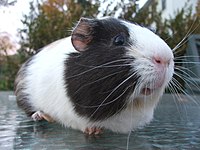
Photo from wikipedia
The association between near work activities and myopia has not been clearly established. This study establishes a model for near work myopia (NWM) induced by short viewing distance in guinea… Click to show full abstract
The association between near work activities and myopia has not been clearly established. This study establishes a model for near work myopia (NWM) induced by short viewing distance in guinea pigs with a carefully controlled visual environment, and evaluates the effect of viewing distance in myopia development. Pigmented guinea pigs (3 weeks old) were randomly assigned to 3 groups: near work (NW)-, form-deprivation (FD)-, and -4D hyperopic-defocus (HD)-induced myopia. Animals in NW groups were kept in cylindrical cages with vertical square-wave gratings, providing short- (S, d = 18 cm), middle- (M, d = 44 cm), and long- (L, d = 88 cm) mean viewing distances, all at the same illuminance, during daily treatment for 14 days. Biometric parameters, including refraction, anterior chamber depth (ACD), lens thickness (LT), vitreous chamber depth (VCD), and axial length (AL), were measured at the beginning and end of 14 days' treatment. Choroidal thickness (ChT) and choroidal blood perfusion (ChBP) were measured by optical coherence tomography (OCT) and OCT-angiography (OCTA), respectively, at the end of treatment. Refraction was shifted towards myopia in the S-cage group, compared with the M- and L-cage groups; refractions in the L-, M- and S-cage groups were 5.19 ± 0.65 D, 4.30 ± 0.64 D, and 0.53 ± 0.61 D, respectively (p < 0.001). VCD and AL in the S-cage group increased in parallel with the myopic shift (L vs M vs S: VCD: 3.15 ± 0.02 mm vs 3.17 ± 0.02 mm vs 3.26 ± 0.02 mm, p < 0.001; AL: 7.99 ± 0.03 mm vs 8.03 ± 0.03 mm vs 8.15 ± 0.02 mm, p = 0.001). In FD and HD eyes, changes similar to those in the S-cage group (near-work group, NW) were seen in refraction (NW vs FD vs HD: 5.36 ± 0.82 D vs -5.78 ± 0.44 D vs -4.96 ± 0.54 D, p = 0.734), ACD, LT, VCD and AL. Also, ChT and ChBP were significantly less in the S-cage group than in the M- and L-cage groups after 14 days' treatment (L vs M vs S: ChT: 74.84 ± 3.27 vs 76.07 ± 3.49 vs 61.95 ± 3.31, P = 0.002; ChBP: 48.32 ± 2.23 vs 48.66 ± 2.30 vs 38.14 ± 2.06, p = 0.002). Rearing in S-cages induced myopia in guinea pigs and correspondingly decreased ChBP and ChT. The present study provides objective evidence that short viewing distance could be a risk factor for myopia, and describes a useful model for studying the underlying mechanisms.
Journal Title: Experimental eye research
Year Published: 2022
Link to full text (if available)
Share on Social Media: Sign Up to like & get
recommendations!